Mad Hedge Biotech & Healthcare Letter
August 19, 2021
Fiat Lux
FEATURED TRADE:
A LOW-PROFILE BIOTECH WINNER
(VRTX), (ACAD), (SRPT), (FGEN), (MRK), (MRNA), (NVS), (XLRN), (PTGX), (IONS), (BLUE), (EDIT), (ABBV)

Mad Hedge Biotech & Healthcare Letter
August 19, 2021
Fiat Lux
FEATURED TRADE:
A LOW-PROFILE BIOTECH WINNER
(VRTX), (ACAD), (SRPT), (FGEN), (MRK), (MRNA), (NVS), (XLRN), (PTGX), (IONS), (BLUE), (EDIT), (ABBV)

Choosing winners among biotechnology and healthcare stocks these days isn’t easy.
Since the year started, the sector has been marred with several unexpected disappointments like the 50% decline of crowd favorites Acadia Pharmaceuticals (ACAD) and Sarepta Therapeutics as well as the 33% fall of the ever-dependable FibroGen (FGEN).
So, how can investors pick a winner?
One tactic is taking a peek at what Wall Street analysts are doing, noting which among the companies they’re following are trading the farthest below the estimated price points.
Among the names on the list, a particular stock stands out as a strong contender these days: Vertex Pharmaceuticals (VRTX).
Although it’s one of the most widely known biotechnology companies today, Vertex actually started in a garage of a Harvard-trained chemist, Joshua Bogner, who left his cushy job at one of the most illustrious big pharma companies at that time, Merck (MRK), to pursue his vision.
The company’s raison d’être was a major selling point for a lot of talented and idealistic scientists in that era.
That is, Vertex wanted to find cures for the most challenging diseases and do this in an unbureaucratic setting.
Since then, Vertex’s goal has been straightforward: tackle the most complex and toughest diseases and deliver breakthrough treatments that offer tangible benefits to patients.
Over the years, the company has managed to keep this goal at the forefront of its efforts, starting with its work on the devastating genetic disorder called cystic fibrosis (CF).
Vertex’s work on CF took over a decade, but it eventually led to an impressive franchise that helped with the treatment of patients.
In the first quarter of 2021 alone, sales in this segment reached $1.7 billion.
Expanding on its work, Vertex has explored genetic therapies and set up a collaboration with Moderna (MRNA) in 2016.
Using the latter’s well-established expertise in messenger RNA technology, the companies are expected to come up with more aggressive and advanced CF treatments in the coming years.
Given these developments, Vertex reiterated its 2021 sales guidance to be somewhere in the range of $6.7 and $6.9 billion. Meanwhile, sales of its CF franchise are estimated to peak at $9 to $10 billion—if not higher—by 2024.
Aside from its work on CF, Vertex has also been pouring resources on developing treatments for severe sickle cell anemia and beta thalassemia, a rare blood disorder.
In fact, the company has been looking into these developments as the next major revenue stream, as seen in its bolstered collaboration deal with CRISPR Therapeutics (CRSP).
In this deal, Vertex paid the smaller biotechnology company $900 million upfront plus a potential addition of $200 million following the first regulatory approval of their therapy, CTX001.
While this may sound like a hefty deal to some, Vertex actually values CTX001 at roughly $11 billion.
CTX001, which is a one-time therapy, is priced at roughly $1 million per patient. At this point, the market for beta thalassemia is valued at $32 billion.
Needless to say, this would make CTX001 a massive income generator in the next few years.
Considering the lucrative market for beta thalassemia, though, it’s no surprise that several competitors have emerged to grab their share as well.
Some companies, such as Novartis (NVS) and Acceleron (XLRN), offer maintenance drugs for the disease.
Meanwhile, others like Protagonist Therapeutics (PTGX) and Ionis Pharmaceuticals (IONS) are attempting to develop treatments that would become direct competitors of CTX001.
However, the closest rivals of the Vertex-CRISPR candidate are from Bluebird Bio (BLUE) and Editas Medicine (EDIT).
While this has become a crowded space, Vertex and CRISPR remain the leaders in this segment, as most of the other candidates are still in the investigation phase.
Since it was founded in the 1980s, Vertex has remained true to its vision of tackling some of the toughest diseases out there.
While big pharmaceutical companies, such as AbbVie (ABBV), decided to expand their portfolio through acquisitions, Vertex leveraged its talent pool and maximized its funds by establishing strategic collaborations instead.
This tactic provided the company with enough elbow room that eventually led to its dominance in the CF space, where it now enjoys a virtual monopoly until at least the next decade.
Meanwhile, it has forged strong relationships with promising biotechnology companies and can very well be on its way to becoming the most dominant force in the rare blood disorder segment.
Overall, Vertex Pharmaceuticals is an attractive stock with an impressive portfolio and an even more impressive pipeline.
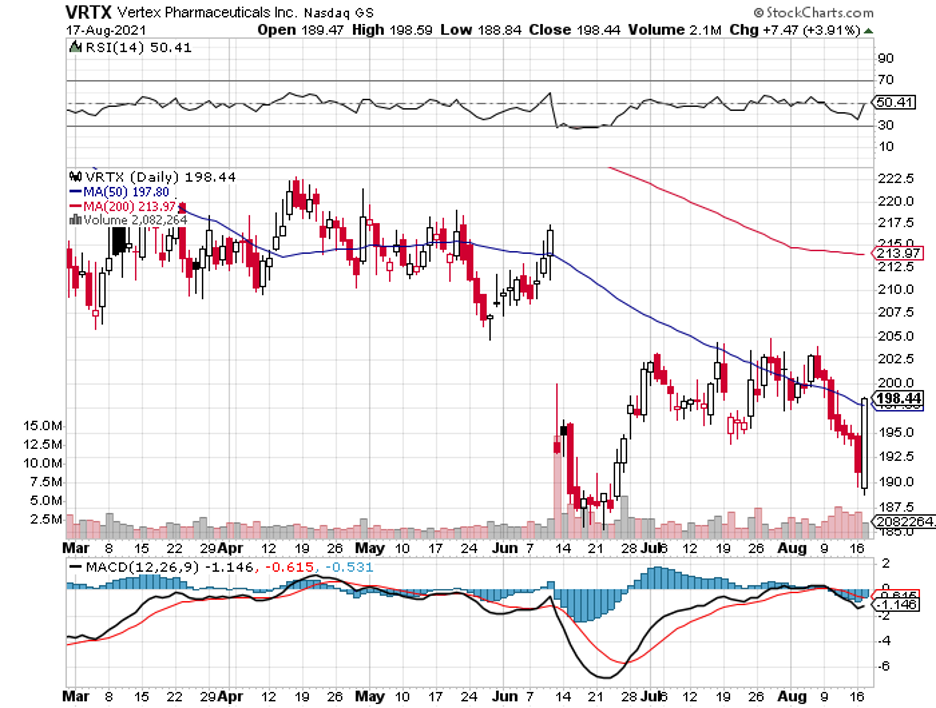
Mad Hedge Biotech & Healthcare Letter
August 5, 2021
Fiat Lux
FEATURED TRADE:
(LET THE BIOTECH BUYOUTS BEGIN)
(TBIO), (SNY), (MRNA), (PFE), (BNTX), (ARCT), (GSK), (JNJ), (MRK), (BLUE), (CVAC)
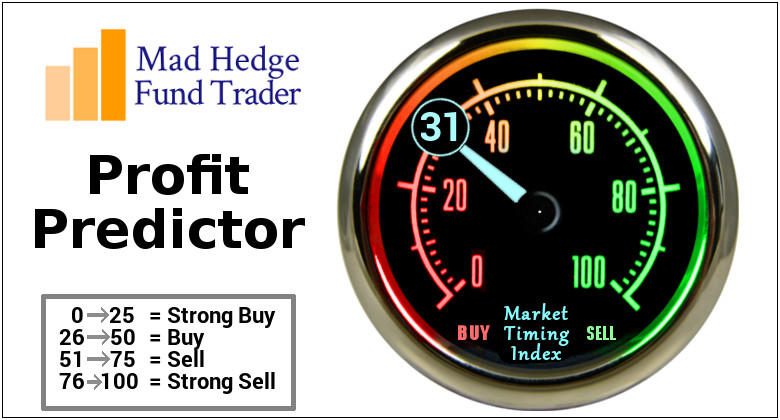
One of my predictions for this year just came true: the biotechnology buyouts have begun.
In my letter last January, I forecasted that the growing popularity of the mRNA technology courtesy of the COVID-19 vaccines from Moderna (MRNA) and Pfizer (PFE / BioNTech (BNTX) would trigger acquisitions of smaller biotechnology companies this year.
I predicted that bigger players in the healthcare industry would scoop up smaller players to stake a claim in this quickly growing space.
Topping our list of buyout candidates is Translate Bio (TBIO)—the very same company hogging headlines in the past days following its $3.2 billion acquisition by Sanofi (SNY).
The all-cash deal values each TBIO share at $38, representing a premium of over 30% above the stock’s price. If all goes well, the deal should be completed by the third quarter of 2021.
This is one of the first major moves by Sanofi following the healthcare giant’s recent pivot into vaccines.
However, this isn’t the first time Sanofi and TBIO worked together.
The two companies have actually started collaborating back in 2018, working on a potential mRNA-based flu vaccine—a project that has Sanofi and TBIO ahead of the pack, with BioNTech and Arcturus Therapeutics Inc. (ARCT) trailing behind.
Sanofi and TBIO’s mRNA seasonal flu vaccine candidate is expected to commence with Phase 1 results expected to be out by the fourth quarter of this year.
Considering that Sanofi is one of the leading vaccine makers in the world with roughly $3 billion in sales in flu vaccines alone in 2020, it won’t come as a surprise if their candidate breezes through the trials.
Even prior to this acquisition, Translate Bio has been working on using its mRNA platform to develop vaccines and treatments for a broad range of diseases like liver and pulmonary ailments.
So far, its novel pipeline has 2 clinical-stage programs along with 7 pre-clinical work covering direct therapeutics and vaccines.
One of its lead candidates is MRT5005, which is an mRNA-based therapy for cystic fibrosis (CF).
This is a groundbreaking treatment because it takes advantage of mRNA’s capability to deliver proteins to lung cells. It’s also extremely non-invasive, as patients can simply inhale the mRNA drug into their bodies.
Other than helping with the treatment of CF, this inhalation delivery system can also open avenues for other pulmonary targets.
Most importantly, TBIO’s MRT5005 doesn’t only offer treatments. It actually is a cure for CF.
TBIO’s work on CF treatment is extremely important. This disease is terrible, recording a median age of death among patients in the US as 30.6 years old. In this country alone, over 30,000 people suffer from the condition, and more than 70,000 are recorded worldwide—and the numbers continue to climb each year.
In terms of the CF market, the global demand for treatments for this disease is expected to reach $16.3 billion by 2026, hitting roughly 16.8% in CAGR over the years.
With the acquisition of Translate Bio, Sanofi plows ahead of its competitors in the space, including Pfizer, GlaxoSmithKline (GSK), Johnson & Johnson (JNJ), and Merck (MRK), as the sole Big Pharma company with a wholly-owned in-house mRNA platform.
This is on top of Sanofi’s recent $470 buyout of another mRNA company, Tidal Therapeutics, to bolster its immuno-oncology and inflammatory diseases segments.
Apart from its aggressive buyout strategy, Sanofi also announced its plan to allocate roughly $476 million annually to a “vaccines mRNA Center of Excellence” with the goal of queuing at least six mRNA-based candidates in clinical trials by 2025.
Allotting $476 million to this plan is a telling move on the company’s future direction, as it comprises a substantial fraction of Sanofi’s $6.5 billion overall R&D budget.
These moves strongly signal that Sanofi’s going all-in on the mRNA platform, which could obviously pose a challenge to the likes of Moderna and, of course, BioNTech.
With smaller cap companies like bluebird Bio (BLUE) and CureVac (CVAC) still up for grabs, it’s only a matter of time before another big company decides to follow suit.
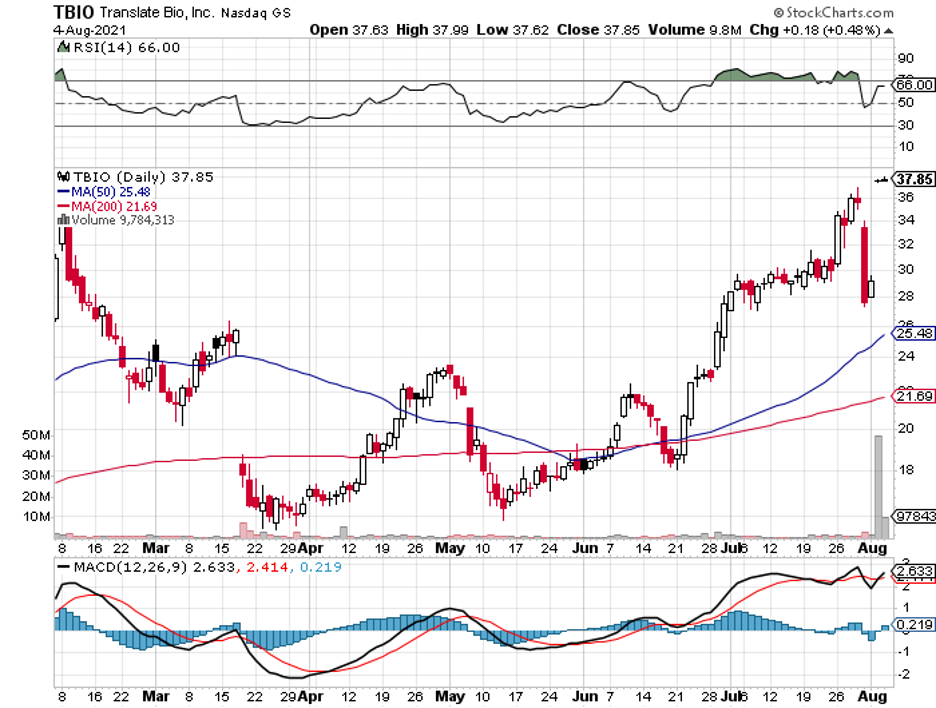
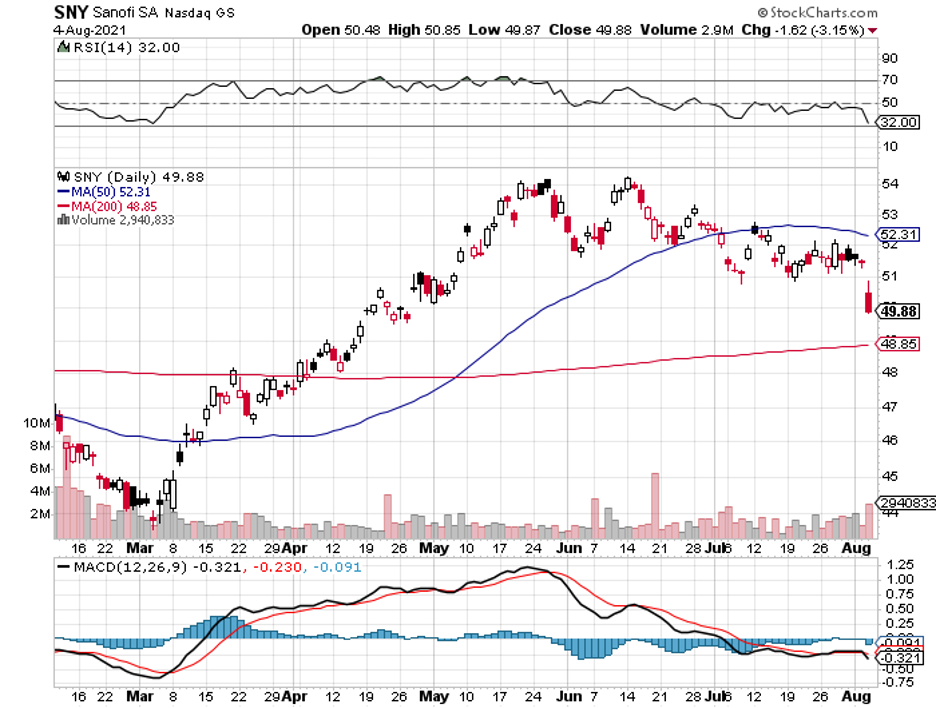
Mad Hedge Biotech & Healthcare Letter
July 22, 2021
Fiat Lux
FEATURED TRADE:
(ANOTHER STEP CLOSER TO NEURO-VICTORY)
(BAYRY), (BIIB), (LLY), (SIOX), (RHHBY), (ABBV), (MRK), (PFE), (AZN)

First, Alzheimer’s. Now, Parkinson’s.
Companies working on neurodegenerative diseases are on a roll.
After Biogen’s (BIIB) work with Aduhelm, another biopharmaceutical company has made notable progress: Bayer (BAYRY).
Merely six weeks after DA01 landed in the clinic, Bayer’s Parkinson’s disease drug candidate is getting into the fast lane.
This marks one of the major pipeline candidates that the German company picked up from its $1 billion acquisition of Versant Ventures in 2019.
DA01 is described as a “pluripotent stem cell-derived dopaminergic neuron therapy.”
In layman’s terms, Bayer collects donor cells that have the ability to develop into any other cell type in the body.
It will then engineer these versatile cells to turn into neurons that have the capacity to produce the neurotransmitter dopamine—aka the chemical your nervous system uses to transmit messages to nerve cells.
Those engineered neurons will then be transplanted into a part of the brain, called the putamen, which is in charge of our movements and learning.
What we know so far is that the next phase of the trial will determine the safety and tolerability of the cell transplantation a year following the procedure.
This will also tell us more about the cell survival rate after the transplant and the motor effects a year or two following the procedure.
Like Biogen’s Alzheimer’s candidate, the fast-track designation with the FDA could open doors for a speedy review or even an accelerated approval for Bayer’s DA01.
Aside from transplanting engineered cells into patients’ brains, the company is also looking into other options for Parkinson’s.
In October 2020, it shelled out $2 billion upfront to acquire Asklepios BioPharmaceutical or AskBio for its gene therapy research on Parkinson’s.
Roughly 1 million people in the US are suffering from Parkinson’s disease—a number that’s greater than the combined number of patients diagnosed with Lou Gehrig’s disease, multiple sclerosis, and muscular dystrophy.
What’s worse is that this is expected to climb to 1.2 million by 2030.
In terms of treatment cost, the combined expenses for Parkinson’s, including medical bills and lost income, are estimated to reach about $52 billion annually in the US alone.
The medications alone already amount to an average of $2,500 per year, with therapeutic surgery reaching up to $100,000 per person.
This is why it comes as no surprise that several companies have been working towards figuring out a more potent treatment or even cure for Parkinson’s.
One of the frontrunners is Prevail Therapeutics, a New York-based biotechnology company that’s focused on developing a gene therapy for this disease.
Following a successful Series B financing round in 2019, in which it secured $50 million in investments, the company eventually attracted the attention of big pharma.
By December 2020, it was acquired by Eli Lilly (LLY) for $880 million with the promise to help the smaller biotech company develop three of its most promising Parkinson’s candidates.
Another Parkinson’s-centered biotech company is Axovant Gene Therapies, which has been working on a single-dose treatment for neurodegenerative disease.
Its pipeline proved to be promising, as seen in its $74.7 million public offering just last February 2020, with the company maintaining its solid footing amid the pandemic.
By November, it rebranded itself as Sio Gene Therapies (SIOX).
Outside the US is Irish biotech firm Inflazome, which is working on a unique treatment for Parkinson’s.
Unlike the other candidates, the goal of Inflazome’s drug is to directly deliver the treatment to the affected neurons. That is, it plans to pass through the blood-brain barrier.
Its research attracted the Michael J. Fox Foundation, which granted it $1 million in funding, in March 2019.
Since then, the company’s progress has attracted the attention of other major biopharmaceutical companies with Roche (RHHBY), ultimately landing the acquisition in September 2020.
Of course, talks about neurodegenerative diseases wouldn’t be complete without Biogen.
On top of its Alzheimer’s work, the Massachusetts biotechnology giant has been collaborating with San Francisco-based Parkinson’s company Denali Therapeutics.
The two have been working on the development of three small molecular drugs for $560 million in upfront payments plus $465 million in equity investment into the smaller biotech.
In addition to these, we’re still waiting on what the rest of the major biopharmaceutical companies would come up with in the future.
Given that the likes of AbbVie (ABBV), Merck (MRK), Pfizer (PFE), and AstraZeneca (AZN) have all signed up publicly via the Critical Path for Parkinson's (CPP) consortium to tackle this debilitating disease, it’s safe to say that there’s hope for the future of this sector.
First, Alzheimer’s. Now, Parkinson’s.
Companies working on neurodegenerative diseases are on a roll.
After Biogen’s (BIIB) work with Aduhelm, another biopharmaceutical company has made notable progress: Bayer (BAYRY).
Merely six weeks after DA01 landed in the clinic, Bayer’s Parkinson’s disease drug candidate is getting into the fast lane.
This marks one of the major pipeline candidates that the German company picked up from its $1 billion acquisition of Versant Ventures in 2019.
DA01 is described as a “pluripotent stem cell-derived dopaminergic neuron therapy.”
In layman’s terms, Bayer collects donor cells that have the ability to develop into any other cell type in the body.
It will then engineer these versatile cells to turn into neurons that have the capacity to produce the neurotransmitter dopamine—aka the chemical your nervous system uses to transmit messages to nerve cells.
Those engineered neurons will then be transplanted into a part of the brain, called the putamen, which is in charge of our movements and learning.
What we know so far is that the next phase of the trial will determine the safety and tolerability of the cell transplantation a year following the procedure.
This will also tell us more about the cell survival rate after the transplant and the motor effects a year or two following the procedure.
Like Biogen’s Alzheimer’s candidate, the fast-track designation with the FDA could open doors for a speedy review or even an accelerated approval for Bayer’s DA01.
Aside from transplanting engineered cells into patients’ brains, the company is also looking into other options for Parkinson’s.
In October 2020, it shelled out $2 billion upfront to acquire Asklepios BioPharmaceutical or AskBio for its gene therapy research on Parkinson’s.
Roughly 1 million people in the US are suffering from Parkinson’s disease—a number that’s greater than the combined number of patients diagnosed with Lou Gehrig’s disease, multiple sclerosis, and muscular dystrophy.
What’s worse is that this is expected to climb to 1.2 million by 2030.
In terms of treatment cost, the combined expenses for Parkinson’s, including medical bills and lost income, are estimated to reach about $52 billion annually in the US alone.
The medications alone already amount to an average of $2,500 per year, with therapeutic surgery reaching up to $100,000 per person.
This is why it comes as no surprise that several companies have been working towards figuring out a more potent treatment or even cure for Parkinson’s.
One of the frontrunners is Prevail Therapeutics, a New York-based biotechnology company that’s focused on developing a gene therapy for this disease.
Following a successful Series B financing round in 2019, in which it secured $50 million in investments, the company eventually attracted the attention of big pharma.
By December 2020, it was acquired by Eli Lilly (LLY) for $880 million with the promise to help the smaller biotech company develop three of its most promising Parkinson’s candidates.
Another Parkinson’s-centered biotech company is Axovant Gene Therapies, which has been working on a single-dose treatment for neurodegenerative disease.
Its pipeline proved to be promising, as seen in its $74.7 million public offering just last February 2020, with the company maintaining its solid footing amid the pandemic.
By November, it rebranded itself as Sio Gene Therapies (SIOX).
Outside the US is Irish biotech firm Inflazome, which is working on a unique treatment for Parkinson’s.
Unlike the other candidates, the goal of Inflazome’s drug is to directly deliver the treatment to the affected neurons. That is, it plans to pass through the blood-brain barrier.
Its research attracted the Michael J. Fox Foundation, which granted it $1 million in funding, in March 2019.
Since then, the company’s progress has attracted the attention of other major biopharmaceutical companies with Roche (RHHBY), ultimately landing the acquisition in September 2020.
Of course, talks about neurodegenerative diseases wouldn’t be complete without Biogen.
On top of its Alzheimer’s work, the Massachusetts biotechnology giant has been collaborating with San Francisco-based Parkinson’s company Denali Therapeutics.
The two have been working on the development of three small molecular drugs for $560 million in upfront payments plus $465 million in equity investment into the smaller biotech.
In addition to these, we’re still waiting on what the rest of the major biopharmaceutical companies would come up with in the future.
Given that the likes of AbbVie (ABBV), Merck (MRK), Pfizer (PFE), and AstraZeneca (AZN) have all signed up publicly via the Critical Path for Parkinson's (CPP) consortium to tackle this debilitating disease, it’s safe to say that there’s hope for the future of this sector.
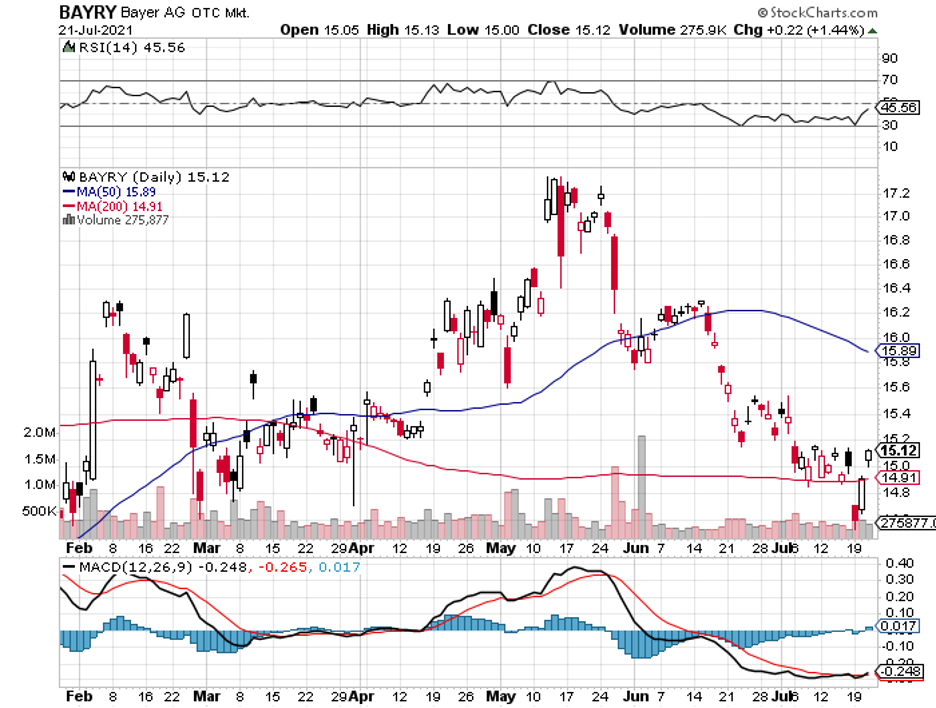
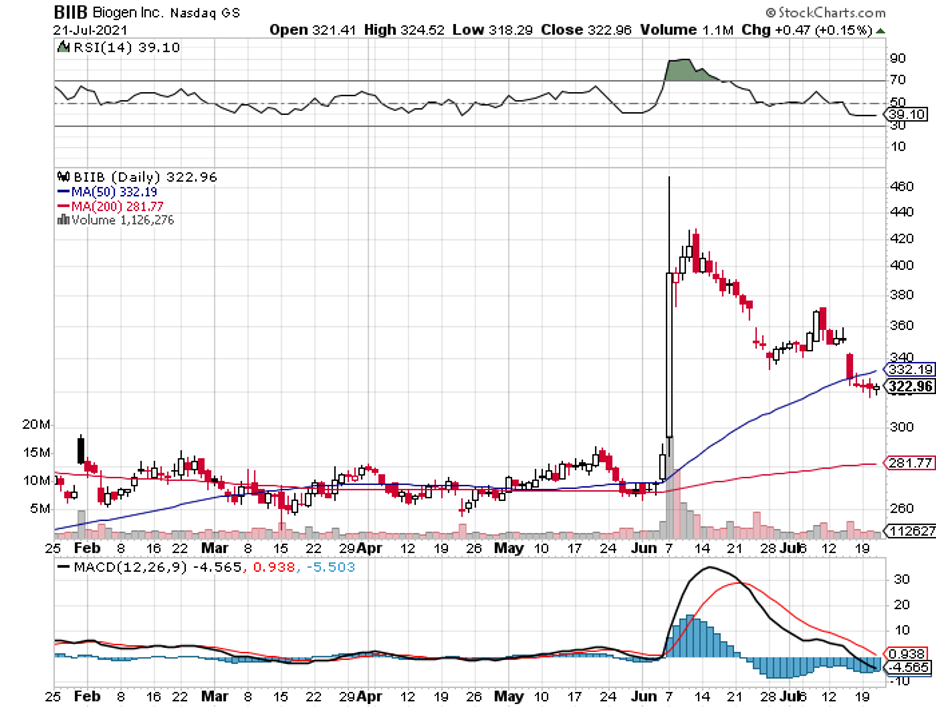
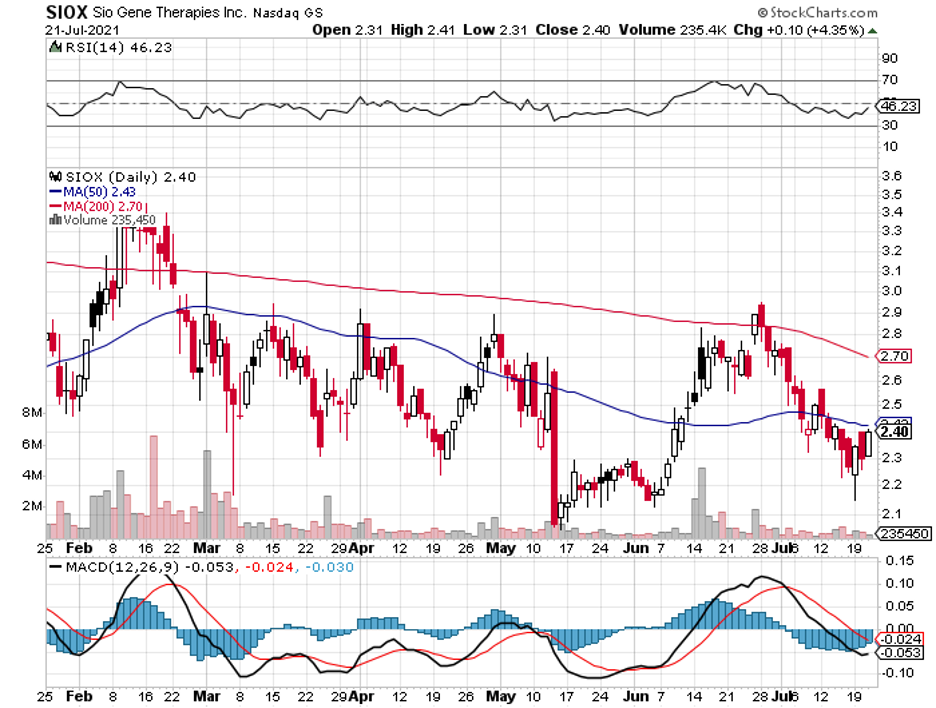
Mad Hedge Biotech & Healthcare Letter
July 13, 2021
Fiat Lux
FEATURED TRADE:
(SPINOFF STOCKS POISED FOR LONG-TERM GROWTH)
(VTRS), (OGN), (PFE), (MRK), (JNJ), (LLY), (ABBV),
(AZN), (GSK), (BMY), (GILD), (REGN), (PYPL), (EBAY), (CARR), (UTC)

Spinoffs have historically been known to deliver healthy returns for their investors.
A good example is PayPal (PYPL), which grew sevenfold since 2015 following its spinoff from eBay (EBAY).
A more recent example is Carrier Global (CARR), which tripled its shares amid the pandemic after its spinoff from United Technologies (UTC) last year.
Basically, spinoffs allow smaller segments of companies to thrive on their own or push high-growth divisions to expand faster.
Over the past months, the cheapest stocks found in the S&P 500 have recently spun off pharmaceutical companies: Viatris (VTRS) and Organon (OGN).
Viatris is a spinoff of Pfizer (PFE), which merged with Mylan, while Merck (MRK) jettisoned Organon (OGN) just last month.
Both are brand new and still under the radar, particularly among investors who don’t follow healthcare updates.
While these two have yet to impress the market, both exhibit potential that could make them promising long-term prospects.
Viatris holds an extensive portfolio of drugs courtesy of Pfizer’s Upjohn unit and Mylan’s pipeline.
The list includes the previously top-selling Lipitor, Viagra, Lyrica, and even Norvasc from Pfizer. It also has Mylan’s income-generating EpiPen along with the company’s HIV/AIDS therapies and 7,500 marketed products across the globe.
To date, Viatris has fallen roughly 30% from its average price target. It’s not for the subpar performance of its products though. This is mostly attributed to the lack of attention from investors and possibly a bit of skepticism from some analysts.
However, Viatris has a really good value proposition.
The main goal of the biggest names in the biopharmaceutical sector, such as Johnson & Johnson (JNJ), Eli Lilly (LLY), AbbVie (ABBV), AstraZeneca (AZN), GlaxoSmithKline (GSK), Bristol-Myers Squibb (BMY), and Gilead Sciences (GILD), is to develop and launch the best-in-class treatments to market.
To achieve that, these industry giants are granted a set period to exclusively sell and market each new drug that gains approval.
This would allow them to command a premium price, which in turn would give them the money to fund the next round of research and development needed to come with the next generation of newer and improved versions of the treatment.
However, not everyone can afford those premium prices.
So when the periods of exclusivity end, there are companies like Mylan—now Viatris—that are allowed to manufacture generic versions of those branded drugs and sell them at lower prices.
The list of drugs with soon-to-expire patents for which Viatris has been working on creating biosimilars or generic versions include Humira from AbbVie, which recorded peak sales at $20 billion; Eylea from Regeneron (REGN), which peaked at $7.5 billion; and even Allergan’s Botox, which peaked at $5 billion.
Viatris is also working on biosimilars for Roche’s (RHHBY) cancer treatments Avastin, which had peak sales of $7 billion, and Perjeta, which peaked at $5 billion.
Obviously, Viatris will not reach the same height of success as the companies that created those branded drugs.
But, if it manages to achieve even only 10% of those numbers, then it can generate roughly $4 to $5 billion in sales—and that’s just the tip of the iceberg.
So far, Viatris owns at least 1,400 approved molecules applicable in roughly 10 therapeutic segments.
It has roughly 350 products in its pipeline at the moment, with each item estimated to generate approximately $100 million to $500 million in sales.
With its current performance and access to 165 countries and territories, Viatris is expected to generate roughly $224 billion in global sales annually.
With all these in mind, Viatris’ value proposition looks impressively strong to me.
More importantly, this Pfizer spinoff has the capacity to become the world’s first dominant generic and biosimilar drug manufacturer, with its revenues potentially becoming comparable to major pharmaceutical companies at some point.
The same value proposition could be behind Organon, as this newly spun-off company markets Merck’s off-patent drugs.
While the move to separate from its parent company has yet to show tangible results, Organon is projected to rake $6.1 billion to $6.4 billion in revenue for 2021, with annual sales expected to rise in mid-single digits and dividends anticipated to be about 3%.
The biosimilars market is still relatively young, with only 60 biosimilars approved in the EU and 29 in the US thus far. In total, those represent a market worth approximately $17 billion.
Conservative estimates project that the global biosimilars market will be worth $692 billion by 2027, considerably outpacing the mainstream pharmaceutical sector.
Given their potential and prospect for future gains, the low prices for companies like Viatris and Organon present rare opportunities to grab long-term investments.
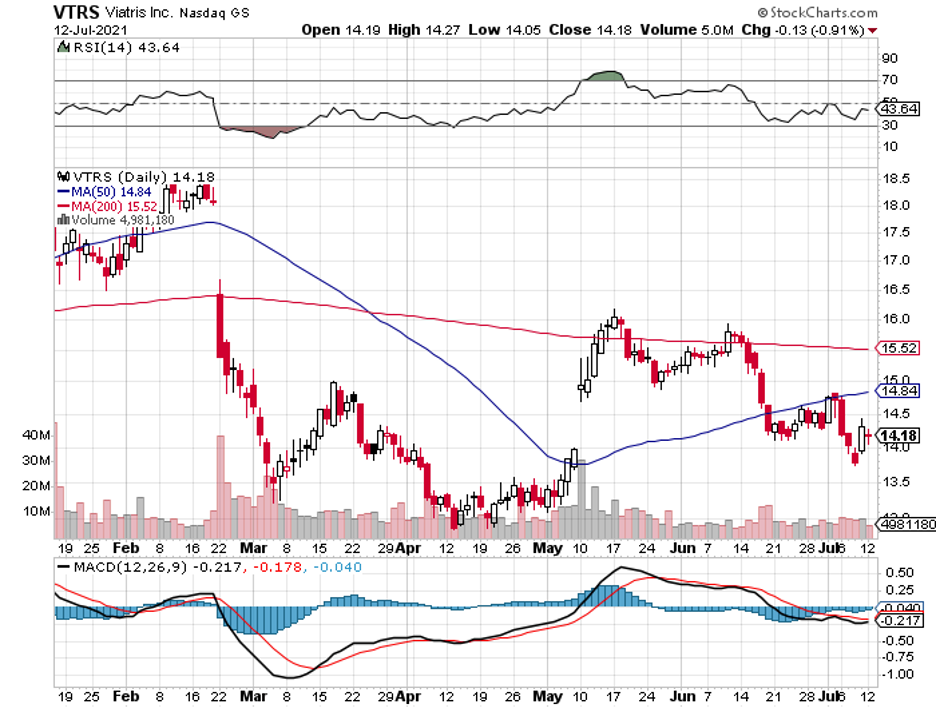
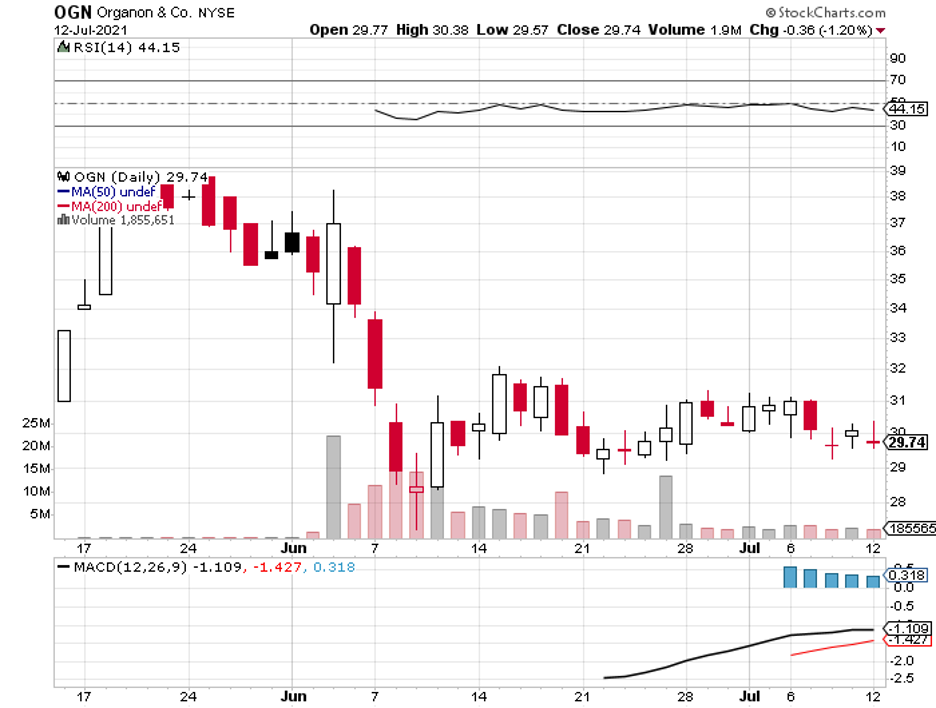
Mad Hedge Biotech & Healthcare Letter
July 6, 2021
Fiat Lux
FEATURED TRADE:
(A PROMISING BIOTECH FOR RISK-TAKERS)
(AXSM), (AMGN), (MRK)
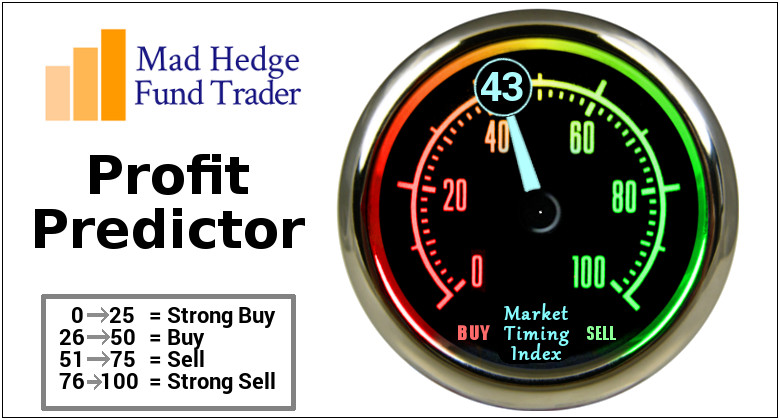
Biotechnology companies are known as the riskiest investments in the stock market. More often than not, they are small, cash-strapped, and with futures so closely tied up to the success or failure of a single clinical study.
For each Amgen (AMGN), which exploded from a market capitalization of less than $1 billion roughly 30 years ago to a whopping $137.15 billion today, there are thousands that fail and fall into obscurity.
However, when a biotech makes it big, the rewards can be transformative—and this speckle of hope is what makes this industry incredibly exciting and interesting.
Let’s take Axsome Therapeutics (AXSM) as an example.
This stock has been beaten down, but its pipeline programs still hold the potential to inflate the portfolios of its shareholders if their science proves to be successful.
Actually, things appear to be turning around for Axsome these days.
Focused on developing novel and innovative treatments for central nervous system disorders, Axsome’s stock price recently enjoyed a 13% climb thanks to the latest development on one of its pipeline candidates: AXS-14.
AXS-14, which is a fibromyalgia treatment, should be ready for submission by the fourth quarter of 2022.
Looking at the potential target market for this drug, its estimated peak sales are somewhere in the range between $500 million to $1 billion.
Another promising treatment in Axsome’s pipeline is its novel migraine medication, AXS-07, which showed great efficacy results in its Phase 3 trial.
In addition, 74% of patients who took AXS-07 experienced no pain progression from two to 24 hours since taking the medication, with almost 50% of them no longer needing rescue medication.
Given the remarkable results for AXS-07, Axsome plans to submit it for a new drug application in the first half of 2021. In fact, this candidate has shown better results than the current gold standard, Merck’s (MRK) Maxalt.
If approved, this migraine treatment can reach peak sales from half a billion to over $1 billion in the United States alone.
However, the most promising candidate in Axsome’s pipeline is its treatment for major depressive disorder (MDD), AXS-05, which recently received priority review from the US FDA.
If things go as planned, the company plans to submit it for review by August 22 this year.
This drug is also a frontrunner medication for Alzheimer’s Disease (AD) Agitation.
On top of these, its Phase 3 clinical trial of AXS-05 showed that it significantly improved the symptoms of people suffering from depression.
Beyond these conditions, Axsome is also looking into using AXS-05 as treatment for migraines, smoking cessation, and even migraines.
AXS-05 has a massive addressable market, with roughly one-third of the 17 million adults in the US suffering from MDD. This could mean peak sales for this indication alone at $4 billion.
While Axsome still has other promising treatments in its pipeline, these three late-stage candidates clearly indicate a very high ceiling.
All of them have the capacity to reach blockbuster status once approved.
At this point and looking at its recent earnings report, Axsome recorded a cash balance of $164 million. It also still has some money left from its $225 million loan, which means the company can still sufficiently fund its operations and continue with its research into at least 2024.
Considering the timeline it has for the three candidates in its pipeline, it’s reasonable to assume that it can generate sales before that date.
All in all, they could rake in a total of at least $8 billion in sales annually for Axsome—a lucrative leap considering that the company currently only has $2.62 billion in market capitalization.
Given its vast pipeline, host of successful trials thus far, and near-term catalysts, I say this clinical-stage biotech’s lowered prices offer a cautious buying opportunity for investors with a penchant for risks.
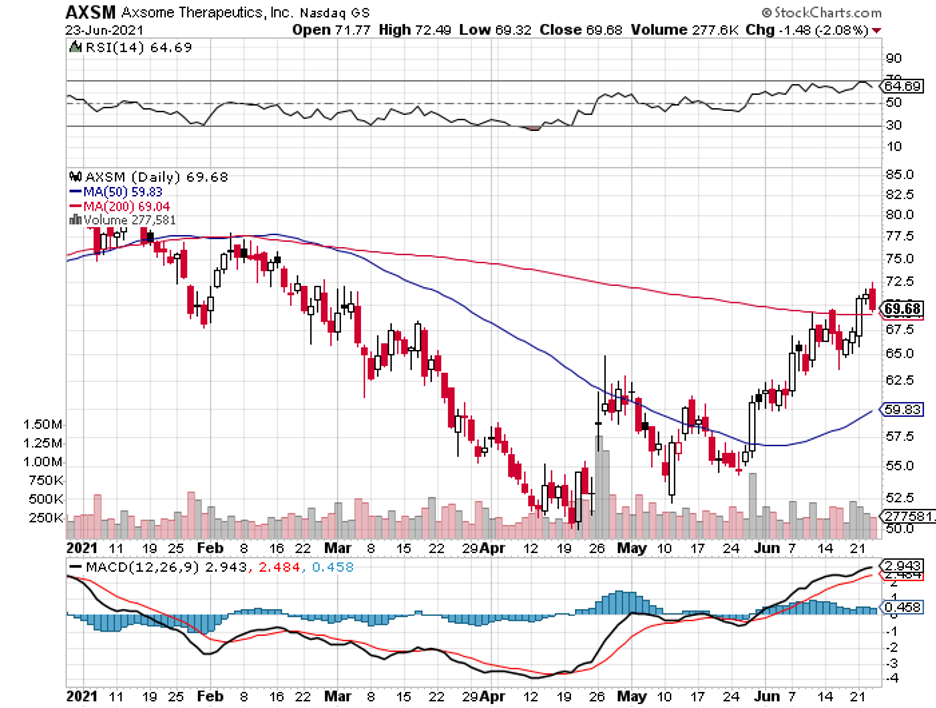
Legal Disclaimer
There is a very high degree of risk involved in trading. Past results are not indicative of future returns. MadHedgeFundTrader.com and all individuals affiliated with this site assume no responsibilities for your trading and investment results. The indicators, strategies, columns, articles and all other features are for educational purposes only and should not be construed as investment advice. Information for futures trading observations are obtained from sources believed to be reliable, but we do not warrant its completeness or accuracy, or warrant any results from the use of the information. Your use of the trading observations is entirely at your own risk and it is your sole responsibility to evaluate the accuracy, completeness and usefulness of the information. You must assess the risk of any trade with your broker and make your own independent decisions regarding any securities mentioned herein. Affiliates of MadHedgeFundTrader.com may have a position or effect transactions in the securities described herein (or options thereon) and/or otherwise employ trading strategies that may be consistent or inconsistent with the provided strategies.
This site uses cookies. By continuing to browse the site, you are agreeing to our use of cookies.
OKLearn moreWe may request cookies to be set on your device. We use cookies to let us know when you visit our websites, how you interact with us, to enrich your user experience, and to customize your relationship with our website.
Click on the different category headings to find out more. You can also change some of your preferences. Note that blocking some types of cookies may impact your experience on our websites and the services we are able to offer.
These cookies are strictly necessary to provide you with services available through our website and to use some of its features.
Because these cookies are strictly necessary to deliver the website, refuseing them will have impact how our site functions. You always can block or delete cookies by changing your browser settings and force blocking all cookies on this website. But this will always prompt you to accept/refuse cookies when revisiting our site.
We fully respect if you want to refuse cookies but to avoid asking you again and again kindly allow us to store a cookie for that. You are free to opt out any time or opt in for other cookies to get a better experience. If you refuse cookies we will remove all set cookies in our domain.
We provide you with a list of stored cookies on your computer in our domain so you can check what we stored. Due to security reasons we are not able to show or modify cookies from other domains. You can check these in your browser security settings.
These cookies collect information that is used either in aggregate form to help us understand how our website is being used or how effective our marketing campaigns are, or to help us customize our website and application for you in order to enhance your experience.
If you do not want that we track your visist to our site you can disable tracking in your browser here:
We also use different external services like Google Webfonts, Google Maps, and external Video providers. Since these providers may collect personal data like your IP address we allow you to block them here. Please be aware that this might heavily reduce the functionality and appearance of our site. Changes will take effect once you reload the page.
Google Webfont Settings:
Google Map Settings:
Vimeo and Youtube video embeds:
